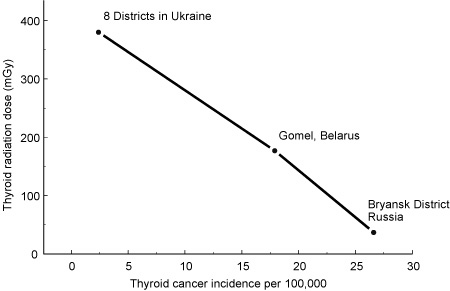Not exactly. 1,000 microseiverts is one milliseivert. One mSv is the average yearly exposure experienced by someone living in the vicinity of Chernobyl between 1986 and 1995. The global average is 2.4 mSv. Normal ranges are between 1 and 10, even though the currently accepted doses are 1mSv for general population and 20mSv for occupationally exposed workers. Outside of the firefighters that died at Chernobyl from radiation, the highest exposures were about 40mSv. There are places in the world such as Iran, France, Brazil, that have yearly exposures between 250 and 800 milliseiverts with no epidemiological evidence of any increased cancers.
And it's interesting that in the region of Chernobyl there is a deficit of cancer among the inhabitants following the incident, not an increase. As far as childhood thyroid cancer goes, the figure following screening in that area was 1800, not 6000 as you, Freddd, stated earlier. And they didn't all die, either. And funny, isn't it, that the most thyroid cancers were found in the areas with the least radiation exposure? Furthermore, the UNSCEAR report makes clear what was and what was not going on:
The Thyroid Cancer Hoax
In its final conclusions on the health effects of the Chernobyl accident, the UNSCEAR report stated the following:"The number of thyroid cancers (about 1,800) in individuals exposed in childhood, in particular in the severely contaminated areas of the three affected countries, is considerably greater than expected based on previous knowledge. The high incidence and the short induction period are unusual. Other factors may be influencing the risk."
One of these factors are what are called "occult" thyroid cancers, those detected at autopsies by histological studies, and which do not cause visible clinical disturbances during the person's lifetime. These occult thyroid cancers occur en masse all over the world. For example, in Canada their incidence is 6,000 per 100,000 population; in Poland it is 9,000; in the United States 13,000; and in Finland 35,000. The highest incidence of thyroid cancers in children found in Russia, before the Chernobyl accident, was 26.6 per 100,000; in Belarus, 17.9; and in Ukraine, 4.9. Thus, the potential for the discovery of "excess" thyroid cancers, after the intense health screening that took place after the accident, is enormous.
According to UNSCEAR data, the increase in thyroid cancers diagnosed in children under 15 years old, began to be seen as early as 1987 in Russia, and in 1990 in Belarus—that is, only one year and four years after the accident. However, the latency time for radiation-induced solid cancers, such as thyroid cancer, is about 10 years. According the data presented in the UNSCEAR 2000 report, there is no relationship (or rather there is an inverse one) between the registered incidence of thyroid cancers in children, and thyroid radiation doses to the population in contaminated areas (Figure 1).
Figure 1 MAXIMUM THYROID CANCER INCIDENCE RATES IN CHILDREN IN HIGHLY CONTAMINATED REGIONS, COMPARED WITH RADIATION DOSE Shown are the maximum thyroid cancer incidence rates in children in highly contaminated regions of Belarus, Russia, and Ukraine, who were under 15 years old at the time of diagnosis, compared with average thyroid radiation doses. As can be seen, the area with the lowest radiation dose has the highest incidence of thyroid cancer.
Thyroid cancers are 90 percent curable. As of this writing, only one of these children has died.
Source: Adapted from UNSCEAR 2000, Annex J, Tables 40 and 57
